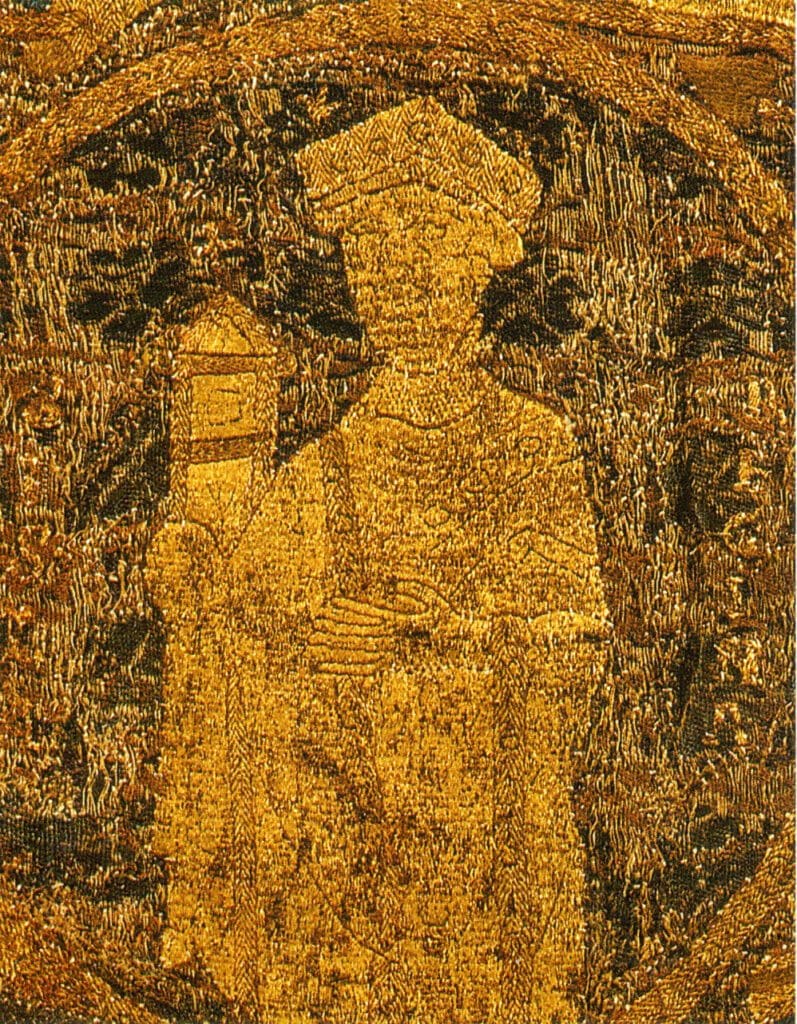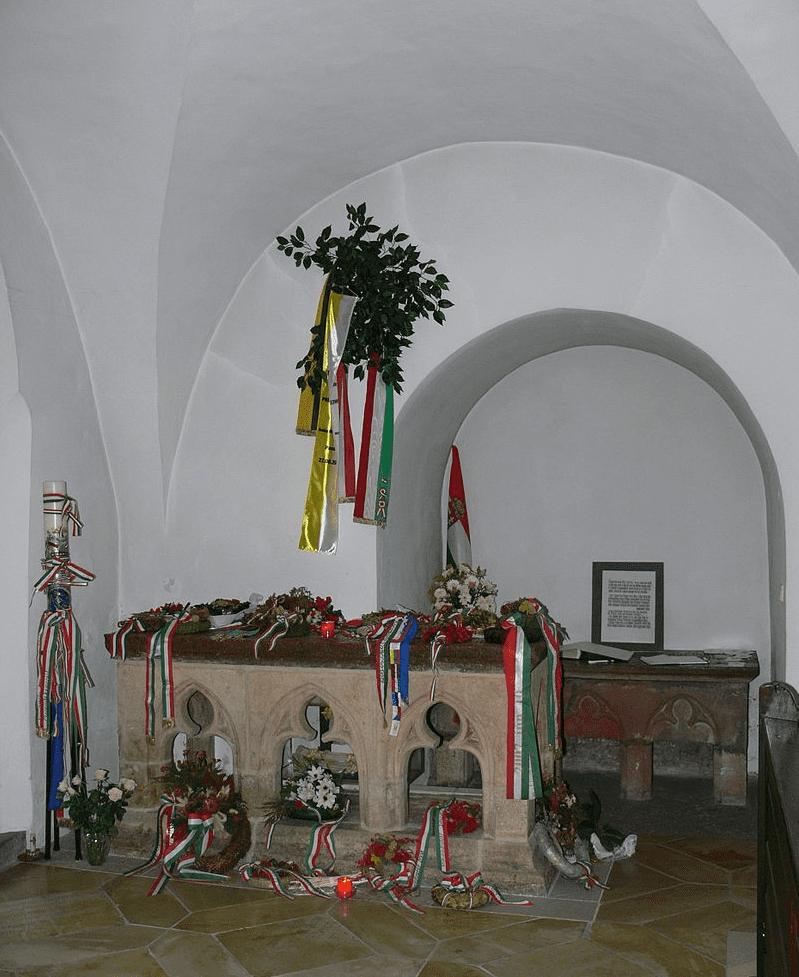The most spectacular attraction of the opening event of the 2023 Veszprém–Balaton project of the European Capital of Culture in January was the appearance of an eight-metre-high mobile puppet representing Gisela of Hungary on the streets of the Transdanubian city of Veszprém. The programme brochure is not wrong when it says that ‘Gisela was a significant opinion-forming cultural partner of Stephen I’, the later canonised first Hungarian king (r. 1000–1038). Gisela was the daughter of Duke Henry of Bavaria and Gisela of Burgundy, and more importantly, the sister of Henry II, Holy Roman Emperor (r. 1002–1024). She was truly a figure of symbolic importance in the founding of the state of Hungary and in the establishing of the country’s Christian church institutions. In addition to strengthening the alliance between the Kingdom of Hungary and the German Empire, her marriage with St Stephen permanently committed the country to Western-style Christianity and development.
For her husband, Gisela symbolised German support. The queen consort certainly played an important role as a transmitter of German culture in almost all areas of life.
It is no coincidence that the sons of the Hungarian royal couple were named after their German royal ancestors, Otto and Emeric (Imre in Hungarian), just as Stephen declared in the preamble to his First Book of Laws that he governed his realm by the measures of late emperors. There is no doubt that the queen consort learned to speak Hungarian to some extent, but at the same time, she was predestined by her mother tongue to be a mediator between the Germans and the Hungarians.
Despite her importance, relatively few contemporary sources have survived about Gisela from which we could draw conclusions about what role she played in the history of the Kingdom of Hungary alongside her husband. According to the few surviving sources, she completely fulfilled the role of a ‘queen consort’ as expected in the Middle Ages. As the Legend of her husband, St Stephen says: ‘How she stood out in adorning the worship of God, and how fervent and beneficent she showed herself [to be] to the congregations serving God is proved to this day by many churches’ crosses, vessels, and ornaments made or woven by marvellous work. And above all the building of the bishopric of Veszprém [proves this] which she adorned nobly, beginning from the foundations, with every necessary thing for the service of God in gold and silver, and a multiplicity of vestments.’[1] With her donations, Gisela supported the Archdiocese of Veszprém, the Provostship of Fehérvár and the Benedictine abbey in Csanád, and, in all likelihood, the foundation of the monastery in Bakonybél can also be connected to her.[2]
However, the historical tradition directly associated with her is rather contradictory, and the range of objects that can be linked to her is very narrow. In addition, German historians tend to be of the view that the conversion of the Hungarians was not due to St Stephen, but to his German wife Gisela, and even more so to Gisela’s brother, Henry II. Moreover, in a legend written in the middle of the 12th century, Emperor Henry was referred to as the ‘apostle of the Hungarians’.
The marriage of Gisela and Stephen may have taken place around 996 AD, which was the first dynastic marriage between a Hungarian princely family and a European ruling family. According to German local tradition, the marriage took place in the Scheyern Abbey in Bavaria, and the young couple was brought together by St Adalbert of Prague himself, the patron saint of the Czech Republic, Poland, and the Duchy of Prussia. However, this is highly unlikely, since the aforementioned sources only give information about the marriage at the earliest from the middle of the 15th century, while the paintings depicting the event come from the 17th century.
The Roman Catholic Archdiocese of Veszprém undoubtedly became the repository of the Hungarian Gisela tradition.
The patron of the cathedral was the queen consort at all times, and Gisela’s crown made from pure gold and decorated with precious stones was also kept there, until King Andrew II sold it during the Fifth Crusade in 1207. From 1216, the pope granted the bishop the right to crown the queen, as well as the office of the queen’s chancellor, so from that year on these posts belonged to the bishop instead of the archbishop of Esztergom.
It is no accident therefore that countless legends are connected to the person of Gisela. As Hungarian tradition that evolved later has it, and as local patriots of Veszprém believe it, Gisela was buried in the St Michael’s Cathedral in Veszprém that she had founded, and not in the Niedernburg Convent in Passau, after her death on 7 May 1065. This misbelief may partly stem from local tradition, but also from a misunderstanding of the 15th-century chronicle of Antonio Bonfini. The mistaken conviction is also supported by an inscription on a memorial plaque erected in honour of the queen consort in Veszprém around 1503, which has survived to this day. But what the plaque really proves is that Gisela was honoured as the founder of the cathedral, first mentioned in a diploma in 1232.
The chasuble donated to the church in Székesfehérvár in 1031, which later became the Hungarian coronation robe, also preserves Gisela’s name and contemporary representation.[3] The image on the chasuble shows the Queen Consort holding a church in her hands, from which many have concluded that she was the founder of the city’s cathedral. However, there is no proof of this, since the first bishoprics in the country were founded by Stephen and not Gisela. It is much more likely that the King gave the city and its bishopric to his wife as a pledge of faith. In addition, the image on the chasuble also suggests that it was woven under the direction of Gisela in a monastery near Veszprém, but again, we have no sources confirming this, as the royal couple had also been represented as founders on another chasuble destroyed during the French Revolution, previously donated to the Pope and preserved in Metz.

As it happens, Hungarian medieval chroniclers did not treat Gisela fairly.[4] The fact that the death of her son, the heir to the throne, Prince Emeric, caused a succession crisis already during Stephen’s lifetime, provided an excellent opportunity to blacken her name. During the family feud, the King had one of his relatives, Vazul, blinded, as he had the strongest claim to succeed him. However, a few years later, it was indeed the descendants of Vazul who acceded to the throne. Faced with this turn of events, the historians of the kings of the royal line of Vazul blamed Gisela for the cruel act, with no basis in fact. The chroniclers went as far as to write about two different Giselas: the ‘good’ Gisela who died when Stephen was still alive, and the ‘evil’ Gisela who became the second wife of the king. The queen consort’s fate became uncertain after the death of Stephen in 1038; the relationship between the next king and Gisela turned sour, so it is likely that in 1045 at the latest, she left the country with the German Emperor Henry III after his visit to Hungary.
The centre of the Gisela cult, at least from the 14th and the 15th centuries on, has been her tomb preserved in the Niedernburg Convent in Passau,
not far from the episcopal cathedral dedicated to St Stephen. The convent standing on a peninsula surrounded by the rivers Danube and Inn gained imperial privileges through Henry II; therefore, the Emperor and his wife were rightly honoured as the convent’s second founders. It is hardly surprising that Gisela retired here as a widow and became the most famous, third abbess in the 11th-century history of the monastery.
In any case, bone remains were found in the place identified as her grave already at the beginning of the 20th century—the skeleton found there belonged to a quite tall woman of about 170 cm. Even more significant is the white limestone cover of Gisela’s 11th-century tomb, which shows a twisted cross with two facing eagles on top. The inscription reveals that Abbess Gisela, who died on 7 May, is buried there. Around 1420, the identification of the abbess as the Hungarian queen consort was already certain, since it was then that the Gothic burial monument seen today was built, with a new tomb slab naming Gisela as King Stephen’s wife. It was the growing fame of the Gisela cult that prompted the widowed Hungarian Queen Maria of Habsburg, fleeing from Buda after the Battle of Mohács in 1526, to pay a visit to her grave in Passau with her escort.

Gisela’s cult in Hungary was revived in the 18th century. In the 1760s and 1770s, and then in the 1930s, several attempts were made to transport her ashes to Hungary. Emperor Franz Joseph was ready to erect a mausoleum for her grave as well, but his death in 1916 prevented him from doing so. The queen consort was beatified two centuries later, in 1975, on the initiative of Ignaz Koller, Bishop of Veszprém (1762–1766). The year of St Stephen in 1938, when her statue was erected in Veszprém, was decisive in her veneration in Hungary, and since 1992, Gisela Days have also been held every year in May. In 1996, as part of the Millennium celebrations marking the 1000th anniversary of the Hungarian conquest of the Carpathian Basin, the Diocese of Passau handed over the queen’s arm bone, which was then ceremoniously placed next to the arm relic (Holy Dexter) of her husband, the first Hungarian king.[5] In 2011, another relic was donated from Passau to the Diocese of Székesfehérvár, where the remains of Gizella’s husband and son, St Stephen and Emeric rest.
Gisela’s grave in Passau is still particularly popular with Hungarians living in Germany and Hungarian pilgrims, as evidenced by the inscriptions on the memorial plaques and wreaths there. The German and Hungarian believers still pray together for the canonisation of Blessed Gisela.
[1] Hartvic, ‘Life of King Stephen of Hungary’, ch. 10., in Thomas F. Head (ed.), Medieval Hagiography: An Anthology, transl. Nora Berend, New York–London, 2001, pp. 384–385.
[2] Christopher Mielke, The Archaeology and Material Culture of Queenship in Medieval Hungary, 1000–1395, Cham, 2021, pp. 39–40.
[3] Katalin E. Nagy, Zsuzsa Lovag, Márta Járó, Ernő Marosi, The Coronation Mantle of the Hungarian Kings, Budapest, 2005.
[4] János M. Bak, ‘Queens as Scapegoats in Medieval Hungary’, in Anne J. Duggan (ed.), Queens and Queenship in Medieval Europe, Woodbridge, 1997, pp. 223–233.
[5] Adrian Bridge, Hungary’s queen meets her match after 1,000 years, Independent (5 May 1996), https://www.independent.co.uk/news/world/hungary-s-queen-meets-her-match-after-1-000-years-1345942.html, accessed 31 January 2023.








